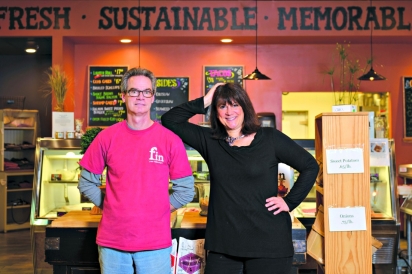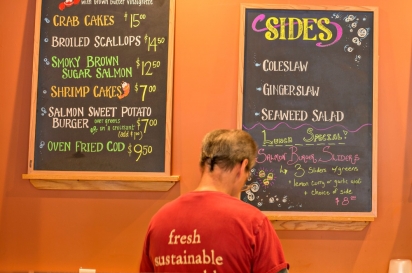Sustaining the Capital Region Fish Fry
Eating virtuously is a full-time job—especially when it comes to responsibly sourced fish in a landlocked region like the Capital District.
While it’s fairly easy to find local, organic dairy, meat and produce at any outlet that sells food, sustainable seafood is less than mainstream (and seems to require a far more complex understanding of the sourcing chain). But seafood’s unique balance of protein, omega-3 fatty acids DHA and EPA, vitamins and minerals, all of which work together to improve child brain development and help the rest of us protect against heart disease, stroke and other chronic diseases, make it an important food source for health-conscious eaters.
So where to turn? Farmed fish? Wild-caught fish? As Dora Swan, co-owner of fin – your fishmonger, dedicated to bringing all 100% sustainable seafood products to the region, tells Edible, “It depends.” In the end, like any other form of farming and resource management, the sustainability of fish is a numbers game, dependent on the size, diet and habitat of the fish in question.
For a landlocked region, the Capital District has an unusually fish-obsessed populace. Blame the Catholics.
“A fish fry, while not being unique to upstate New York, has certainly become rooted in our foodways and one of the iconic dishes visitors from afar and people who move away seek out here,” says Chuck D’Imperio, the author of several works exploring the history of New York, including A Taste of Upstate New York: The People and the Stories Behind 40 Food Favorites, available at Amazon. “One of the reasons fish fries became such an important tradition and dish is because of the prevalence of Roman Catholics in the area. Rochester has 350,000 Catholics, there are 700,000 in Buffalo, 25% of Albany County is Catholic and 35% of Oneida is. Until Vatican II in 1962, they didn’t eat meat on Fridays.”
TGIF? Not so much, Chuck says. He remembers the dread with which he and other kids would sometimes face fish-filled Fridays. “Our moms were really stuck,” he says. “Tuna sandwiches sitting in a lunch box all day at school wasn’t an option, and many people say the whole PB&J sandwich phenomenon is also linked to pre-Vatican II Catholic culture. The only ways moms could get their kids to actually eat—and enjoy—their dinners on Friday was by taking part in what became a ritual that outlived Vatican II: the fish fry.”
Just to be clear: A fish fry is not strictly synonymous with fried fish. Fish fries comprise prodigiously long, narrow and hefty planks of fleshy, juicy white fish fried to a crackling crisp crust. A soft, white bun, homemade or bottled sauces (always tartar and generally cocktail and chili) and accompaniments—including, but not confined to, French fries and coleslaw are typically found as well. Eating a fish fry may not have entailed the “sacrifice” the Church sometimes alluded to with the practice, but it certainly made more New York kids members of the Clean Plate Club.
“First of all, fish fries are delicious,” Chuck says. “I mean, the classic heaving plank of fish, breaded and fried on a white bun with tartar sauce and French fries is great by itself. But in upstate New York, fish fries became an evening of fellowship for the whole community. Thanks to Catholic organizations like the Knights of Columbus and secular organizations like firehouses and community centers, who hosted Friday fish fries for all, they became a place where the country mice and the city mice would get together, where extended families and entire communities would gather and feast together. Fish fries were a place of laughter and togetherness, where your religion or stature in the community were left at the door. When the ban on meat was lifted in 1966, the fish fry became an event that anyone could hold anytime, and frequently did.”
Now, it’s tough to find a non-ethnic restaurant in New York that doesn’t serve some version of the fish fry, from the decidedly un-chic and un-green McDonald’s Filet-O-Fish, to rarified takes on fish ’n’ chips at top-tier seafood establishments. But if you want the kind of fish fry Chuck would approve of, “you have to look for the phrase ‘fish fry’ in the name of the restaurant itself,” he says. A practice applicable to most of New York’s specialty foods, like mini hot dogs or soft-serve ice cream, he says.
“One of the best places I’ve ever been to for a fish fry is Gene’s in East Greenbush,” Chuck says. “I first went there in 1967 when I was a college student in Albany, and I return whenever I can. It’s open seasonally, and it’s family run. When I first went there, it was in the country, but now it’s squeezed in by shopping centers and traffic lights. Mark’s dad, Gene Halsey, opened it in 1961, and there are pictures of Mark as a baby in a corner in a playpen. When Mark and Priscilla had their daughter, Alexia, they brought her into the restaurant to keep them company when she was five days old. Let me tell you, the fish fry they do is second to none, but it’s the thread of community feeling, family and love that is palpable there that makes it really special.”
Unfortunately, the line between fish, fisher and eater has become increasingly indistinct over the years, and for many, the phrase “fish fry” has begun to conjure up distressing sourcing and sustainability questions along with a rumbling stomach.
While the answers may not always be clear-cut, they are available. The fish that’s used in a fish fry—most frequently haddock in upstate New York, but cod and pollack are also frequently used—come from the North Atlantic.
“It’s very confusing, even for us, and we do this for a living,” Dora Swan, who runs and owns Guilderland’s fin – your fishmonger with her partner in business and life, Peter Kenyon. “Getting sustainable fish is not all peace signs and granola. We use four scientific sources— from Monterey Bay Aquarium Seafood Watch and National Oceanic and Atmospheric Administration to the World Wildlife Federation
and the Marine Stewardship Council—and they don’t always agree. And if a mom-and-pop operation is doing the right thing but doesn’t have the money to go through the certification process, they’re not going to get listed. So we do a lot of independent research to make sure the best, most sustainable fish is available at our shop.”
It’s also all sashimi quality and fresh—never frozen.
“We started out in a farmers’ market, and we still operate in that spirit,” Dora says. “We shop locally, and we have a team of people who bring in fish from Boston and know that if something isn’t beautiful and fresh caught, it’s getting sent back.”
Regulations prohibit fin from selling locally caught lake fish, and some fish is flown in (fresh) from India (they work with sustainable shrimp farmers there), Patagonia (sea bass—the only item that arrives frozen due to length of trip) and the West Coast (they carry four to seven types of oysters from the East and West Coast every week). All of it is sourced from hand-picked fishers and farmers who are environmentally responsible, never overfish, refrain from treating farmed fish with antibiotics and never employ slave labor.
“We won’t offer anything in the store that we wouldn’t feel comfortable serving to one of our five grandchildren,” Dora says. An equally important part of their mission, Dora explains, is turning customers onto new kinds of fish. Tuna, salmon, shrimp and tilapia are on the menu, of course, but so are wreckfish, mirror dory, plaice and golden tilefish. Say what?
“No one knows how to pronounce it at first [like ‘place’], but plaice are all the rage in Europe,” Dora says. “Once they trust us enough to
try some of these lesser-known fish, they’ll try new items we recommend for them based on what they’ve liked in the past, and they’ve all come back for more.”
Eating heirloom vegetables, unusual cheeses and free-range meat has become the norm for many consumers who want fresher flavors, variety, more nutrient-dense food or simply an antibiotic, hormone-and pesticide-free plate. It’s slowly happening for seafood, too, and like the earnest embrace of snout-to-tale cuisine, people are returning to the days of yore not just for more diverse options, but for the spirit of community, celebration and joyful feasting that used to surround food, with postmodern, multicultural flair.
“We have a short takeout menu that varies but often involves things like a Korean BBQ taco with kimchi, but we’ve found that our most popular item is our fish fry platter,” Dora says. “And it’s take-out or eat in. We have communal tables, and on Fridays and Saturdays it often turns into a party. Our version is slightly different, made with Icelandic haddock and rice-bran oil. It comes with a seaweed salad and fries, our own spicy cocktail sauce made from hand-ground horseradish and our own tartar sauce.”
The Capital District has always managed to embrace traditional foodways and values while looking ahead via cutting-edge technology to produce a more responsible, just and delicious future. No one at any of the dozens of area farmers’ markets thinks twice about asking producers about spraying, composting, antibiotic and grazing practices. It’s time to bring that boldness to the fishmonger for your next fish fry. She’d love to help.
Fishing in the Capital District
For true locavores, there’s no better way to eat locally and seasonally than to go out and fish for their supper in the many lakes dotting the region.
Common species in regional lakes: pumpkinseed, bluegill, rock bass (great panfish), white crappie, black crappie (the crappie, despite its rather inauspicious name, makes for especially toothsome eating), largemouth bass (favorite for sports fishers), smallmouth bass, northern pike, striped bass, white perch, yellow perch (very popular panfish), walleye (delicious), rainbow trout (a species introduced from the West), brook trout, brown bullhead, channel catfish and common carp.
Anyone 16 and older who fishes in New York State must have a valid license (available at sporting goods stores, tackle shops and town clerks offices).
Consult the Department of Environmental Conservation’s online guide for more information, and a user-friendly map of 35 fishing locations (including what species are most prevalent there) in Albany, Rensselaer, Schenectady and Southern Saratoga counties, plus areas of the Hudson and Mohawk rivers that are safe for anglers to go. The guide: www.dec.ny.gov/ docs/fish_marine_pdf/capdistrictfish.pdf
The New York State Department of Health also has information on what is safest to eat for young children and for women of child-bearing age, plus toxins and chemicals that are prevalent in certain species of fish. The guide: health.ny.gov/environmental/outdoors/fish/health_advisories








